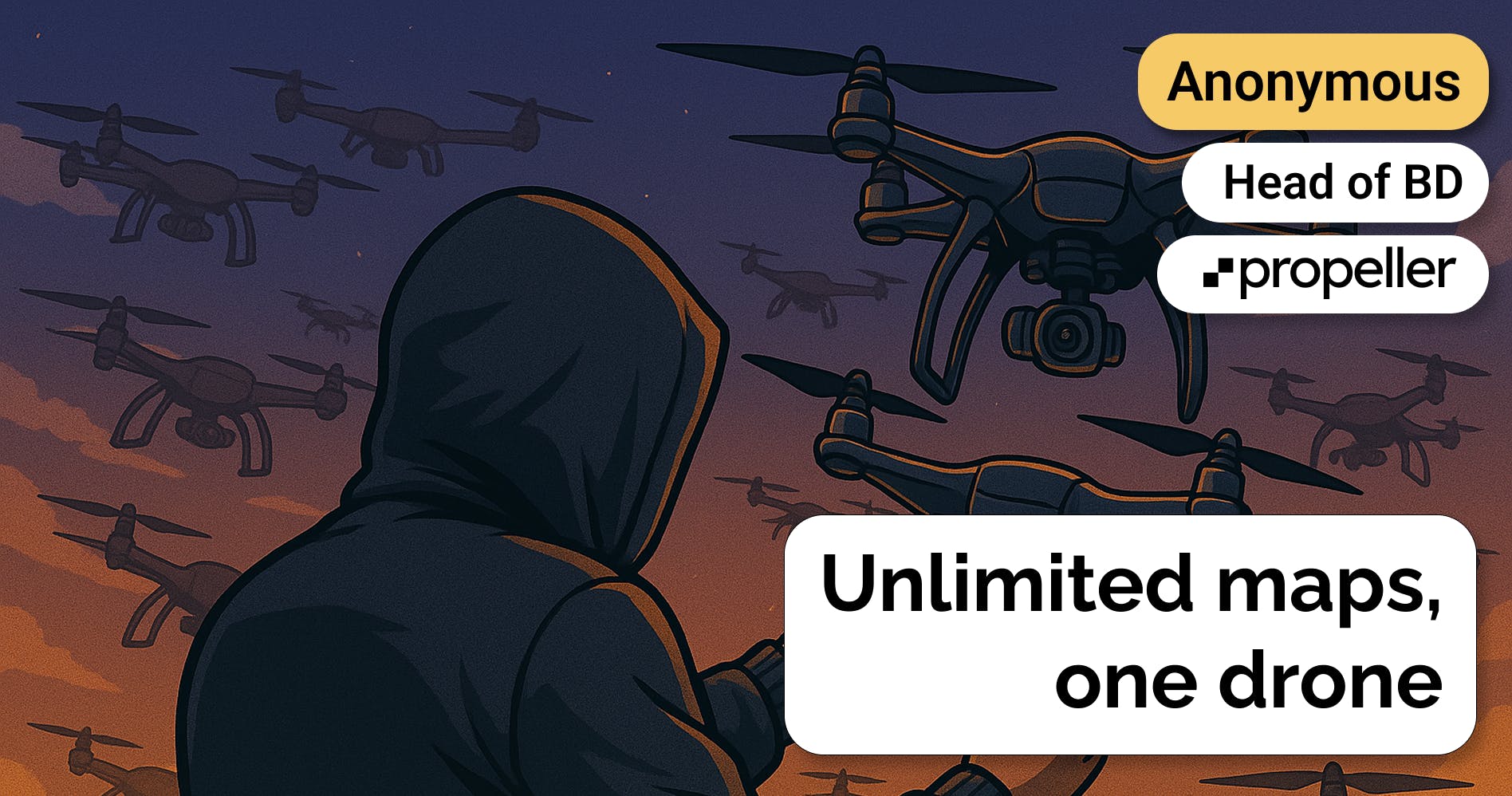Head of Business Development at Propeller Aero on bringing drone mapping to construction and earthmoving
 Jan-Erik Asplund
Jan-Erik Asplund

Questions
- To get started, could you walk me through what Propeller's core value proposition was when you joined and how that changed, if at all, by the time you left?
- At the time of the pivot away from drone delivery, was it just obvious that it was too soon for that to work?
- You mentioned drone service providers. I've talked to folks at large engineering services firms that do inspection and certification. They use a lot of drones but are still service providers—some are publicly listed NYSE companies. Did your enterprise focus include those kinds of service providers, or was it really just all end customers?
- You were head of business development at Propeller. What were some of the business development challenges you faced that were specific to that product space or to the industries you served vs. general BD challenges?
- That's where Trimble came in, right? It seems like that partnership kicked off right around the time you joined Propeller, in 2017. Can you talk about that?
- Specifically in this space?
- With Trimble, did you have some degree of exclusivity, or were there other comparable vendors working with them that also had similar partnerships?
- Looking at the landscape now, you have companies like Propeller, DroneDeploy, Skydio with their cloud product, Bentley Systems, Pix4D—are all these companies intersecting at this data processing and mapping layer?
- Companies like Propeller and DroneDeploy seem focused on the software layer, but Propeller has the AeroPoints and DirtMate hardware. How do you see that balance? Is it all about chasing the software layer, or is it important to have a foothold in hardware as well?
- Does DroneDeploy have anything comparable to AeroPoints or DirtMate?
- With the federal government ban on DJI in the US trickling into commercial use cases, how does that affect companies like DroneDeploy Propeller that have built so much around DJI? I noticed on the Propeller page that at least half of the recommended drone models were DJI.
- How does pricing and contracts work at Propeller? Is it usage-based, like data processing volume-based, or classic SaaS pricing?
- How did you track retention?
- Among your four customer types—mining, construction, aggregates, and waste management—was there one where the product was particularly sticky?
- Among your construction customers at Infrakit, over 80% use drones at least once a month?
- What kind of cool stuff have you seen people do with AI in this space, downstream of data collection?
- You mentioned CAD, but do these systems also turn data into Building Information Modeling (BIM) files?
Interview
To get started, could you walk me through what Propeller's core value proposition was when you joined and how that changed, if at all, by the time you left?
There was a little history of Propeller before me. The company started with drone delivery as the first iteration, but that quickly failed and pivoted to drone mapping. When I started, our drone mapping platform was already established, but the target end customer was drone service providers.
Many of these were people who went to Best Buy or an electronics shop, bought a DJI drone, and decided to start a drone business. Over 80% fell into this category. About 20% were more professional people who took the science behind drone data capture and the actual end products like photogrammetry very seriously.
Right when I came on board, we started switching over to the more professional set. I was part of the catalyst for that switch. We concentrated away from drone service providers almost overnight, 10x'd our price point, which largely eliminated the drone service provider market, and focused on end customers in four core industries: construction, mining, aggregates, and waste management. The core thing among all these is the movement of material—mass quantities of material.
The value proposition, which hasn't changed since then, is 3D visual mapping in the cloud and automated drone data processing. You could do it yourself or get a boost via cloud processing. It was hyper-accurate with Propeller versus other options. The end result was 3D visual mapping and visual decision-making in the cloud.
At the time of the pivot away from drone delivery, was it just obvious that it was too soon for that to work?
The regulations just wouldn't support that. Interestingly enough, when I was in Rwanda a few weeks ago, I watched Zipline, who has made a very successful business in drone delivery. But it's in hyper-remote areas in the backcountry of countries like Rwanda where they're delivering blood and medicines. It's a very niche but very successful business. I saw them peppering the sky—it was amazing to watch. They had very sophisticated drones, almost at the level of Lockheed Martin in terms of drone delivery, but still in a commercial context.
You mentioned drone service providers. I've talked to folks at large engineering services firms that do inspection and certification. They use a lot of drones but are still service providers—some are publicly listed NYSE companies. Did your enterprise focus include those kinds of service providers, or was it really just all end customers?
All end customers. There would be a handful of those engineering services types in the mix, but they were later adopters. Almost ten years ago when I started at Propeller, they weren't even in the mix at the time. The drone service provider then was literally the one-person operation that bought a drone at JB Hi-Fi and was going to do real estate, construction, agriculture—they thought they could be everything to everyone. Those engineering companies didn't come in until later. They're definitely professionals—engineers who adopted drones rather than people without jobs buying drones to start businesses with no engineering or industry background.
You were head of business development at Propeller. What were some of the business development challenges you faced that were specific to that product space or to the industries you served vs. general BD challenges?
The best way to put it is: dirt doesn't move far. If you have to move dirt far, you're losing money. For that reason, all the infrastructure around earthmoving industries is very local, these are regional and at most national businesses.
Propeller was an Australian company trying to make it in America, and a cloud processing company trying to make it in construction, and those were big barriers. To overcome that, we established channel partnerships with companies who already had relationships with all the end customers and were already selling them tech, and not just not drone-related tech.
That's what I was responsible for—building out an entire distribution network through channel partners because selling direct was very challenging. In construction, if an excavator goes down, contractors can't wait for somebody ten states away or two continents away to help. They need help right now because every hour that excavator's down, they're losing money. All the supporting infrastructure around moving dirt has to be supported locally because they don't want any downtime—so all their relationships are local. That’s how they’re accustomed to working.
That's where Trimble came in, right? It seems like that partnership kicked off right around the time you joined Propeller, in 2017. Can you talk about that?
Correct. I was at the forefront of these channel partnerships. Actually on my very first day, I landed in Chicago and went right to Komatsu US headquarters with the CEO, and we started developing the Komatsu relationship as well.
Anyways, those were the two large pulls in the channel strategy.
With Trimble, there was no ownership or investment—just a distribution agreement. We developed Trimble-friendly features, but nothing exclusively for Trimble that wasn't applicable to anyone else. At first, it was more tech-to-tech—understanding file types Trimble customers were already using. It took about a year to really get the distribution and sales side of Trimble to co-invest in terms of time and effort.
Channel distribution is tough. There's always something shinier on their shelf they want to focus on. We have no real leverage—we can't make them do anything. It's all based on margin, and they can say no. Getting it to work successfully was remarkable because we saw others fail at these channel relationships quite poorly.
Specifically in this space?
Yes. Airware would be the first example. They started as Redbird and had a strong relationship with Caterpillar. But what I learned working with Komatsu is that when you're selling a half-million-dollar excavator, a $15,000 or $20,000 piece of software is nowhere near the forefront of anybody's mind. These companies are also very hardware-centric, so it was hard to coach them around the value propositions of a SaaS product. You almost had to retrain salespeople philosophically before even getting into the technical training.
We saw that happen with Kespry as well, the drone company tried to work with John Deere, and that also failed. We picked the right partners and invested in our strategy in the right way to make it successful. But working with channel partners is not easy.
With Trimble, did you have some degree of exclusivity, or were there other comparable vendors working with them that also had similar partnerships?
There were none at the time, and to my knowledge, there still aren't any that are the same. There was never any exclusivity both ways—Propeller didn't offer exclusivity either. A large part of that was because Trimble offers their own drone module as part of Trimble Business Center. The first full year in the partnership was about actually making Trimble people comfortable with an external third-party company coming in when they thought they already had this solved.
The difference was between cloud drone processing and on-premises drone processing. One requires you to learn how to tweak all the dials and learn the science, whereas a construction foreman just wants a quick map, they want to set the drone and forget it—offload everything to the cloud, and get a beautiful map at the end.
Looking at the landscape now, you have companies like Propeller, DroneDeploy, Skydio with their cloud product, Bentley Systems, Pix4D—are all these companies intersecting at this data processing and mapping layer?
You're not wrong. All of them produce the same output—usually a GeoTIFF that's a large single image stitched together from individual images. From that, because the overlap is nice and tight, you can turn it into a three-dimensional model. All that is uniform across these products. Honestly, you can get the exact same results—no one is more accurate than another. Good data in, good data out. It's all in the collection.
That's where the similarity ends, though. There may be differences in how you collect the data, and then in the processing—it either becomes completely democratized through tools like Propeller and DroneDeploy where it’s super simple to get data into the cloud and get useful maps, and then there’s more scientific and academic approaches like what you see with Bentley and Pix4D.
Pix4D is almost a data processing tool, not a data analysis tool. You can do minor things with it, but it’s more in the modeling layer. Then alongside Bentley's Context Capture these tools are more academic—more rigorous engineering-brained tools, not layperson's tools. The number of monthly active users would be ten, twenty, thirty-fold higher with Propeller or DroneDeploy than with Pix4D or Bentley-type products.
Companies like Propeller and DroneDeploy seem focused on the software layer, but Propeller has the AeroPoints and DirtMate hardware. How do you see that balance? Is it all about chasing the software layer, or is it important to have a foothold in hardware as well?
Companies that don't have at least some tight integration do struggle. DroneDeploy has been very tightly integrated with DJI. Propeller is tightly integrated with DJI and now Wingtra. Without that, anyone who is trying to move into this space would naturally struggle.
There's a company called Airworks—a fantastic spin-out from MIT. They take already processed drone data and add an AI layer on top to get CAD outputs automatically. Without knowing the data that came in was good, it would be very hard for them to do a good job. They're always struggling with where the data came from. That’s what I mean by needing a strong integration with the hardware layer.
With Propeller, AeroPoints is unique in that it’s a target you lay down that can take what would naturally be 10 to 20 centimeter accuracy down to one to two centimeter accuracy because the data collected by the drone can be cross-referenced against these targets on the ground collecting GPS data themselves. The decision to couple with hardware is more to ensure data integrity and to lead in the drone mapping segment where highly accurate data is super important, versus just general drone mapping where they may not need that precision.
Does DroneDeploy have anything comparable to AeroPoints or DirtMate?
No. Those would be patented by Propeller I think, and I've never seen anything quite the same. What Propeller did was take the ubiquitous GPS rover—that pole with an antenna cap you see on construction sites—and combine it with a target. They put a GPS at the center of the crosshairs of the target that sits on the ground. There’s nothing else like it that I know of.
DroneDeploy's tight hardware integration is different—they have a flight app that launches DJI drones on specific mission parameters. It's seamless with DJI, so people aren't even using DJI's own tools. DroneDeploy also went very forward with the drone-in-a-box model that DJI has launched recently. In fact, as a rule all new products that come out with DJI are already ready for use on DroneDeploy software.
With the federal government ban on DJI in the US trickling into commercial use cases, how does that affect companies like DroneDeploy Propeller that have built so much around DJI? I noticed on the Propeller page that at least half of the recommended drone models were DJI.
For the six years I was with Propeller, the one year with Precisionhawk before that, and having my own drone AI-based startups before that, there's never been a time where the threat of DJI being banned hasn't been there. It's been perpetual. Has that whole conversation increased in volume? Perhaps a little, but it's been there all along.
Sometimes it's the Chinese angle—someone's listening in. Or it's about fairness to American businesses—how can they produce state-of-the-art, easy-to-operate, amazing drones for a fifth of the cost? That's the reality. That's a very hard barrier to overcome, and I don't see anyone anywhere near that. Skydio, nowhere near that. Wingtra—I love Wingtra, we just hired their head of marketing and I know the CEO well—they're in a price category above DJI, in the $25,000 to $50,000 range for drone hardware. They can't compete against these DJI $2,000 to $5,000 drones that are absolutely amazing.
I've watched the Blue List for a while. We talked about it as an existential risk we couldn't control. But to be honest I cannot see DJI being completely blocked from the market. It'd be like iPhones being blocked from America. I just can't see that happening.
Maybe it'll end up like TikTok—they can't actually shut it down, but they'll make manufacturing happen in the US or something else will happen. That's my opinion—if I were making the bet, I'd bet on some form of TikTok outcome where you'll get DJI, maybe not the same DJI, but a version everyone can live with.
How does pricing and contracts work at Propeller? Is it usage-based, like data processing volume-based, or classic SaaS pricing?
The biggest thing to overcome at first was helping people understand the unit being measured. The most relevant unit when using cloud processing is gigapixels. I'd never heard that term before when I joined Propeller—just megabytes and gigabytes—but that's how Propeller calculated what one map was, up to 40 gigapixels. Anything after that would constitute two maps, three maps, and so on. Then we translated that and boiled it down to credits.
At first, it was packages—15 credits for monthly surveys plus extras, 55 credits for weekly surveys plus extras. Then we introduced an unlimited version, but the limitation there was to a single drone. There's a natural limit—you wouldn't expect a single drone to be shipped all over the country nonstop. So the more natural thing for a business is to buy another drone and get another processing license. Unlimited with one drone became the most popular model.
DroneDeploy was different. They started with a base that was unlimited, but if you wanted higher accuracy, you paid more. Ground control points, extra users—you paid more for each. Their pricing looked really good when you started, but by the time you got everything you wanted, it became more expensive than it seemed.
Propeller's core model is unlimited users, unlimited surveys, unlimited data processing with one drone.
How did you track retention?
They were all annualized contracts, so you're renewing every year. We didn't even use Net Revenue Retention at the time—I hadn't heard the term NRR specifically the whole time at Propeller. We tracked net negative churn—retention was always to the positive side. We tracked how much greater the expansions were than any contraction on an aggregate basis.
Among your four customer types—mining, construction, aggregates, and waste management—was there one where the product was particularly sticky?
Mining has zero price sensitivity. They're thinking half-million-dollar gearboxes, so something like this is a no-brainer if it can save 0.000001%—that's still $100,000. But it's difficult because of remote locations making cloud processing challenging, and security is a big issue for them. Cloud data and processing require very tight regulations. Companies like Propeller and DroneDeploy have mining customers, but I wouldn't say they're number one in mining.
Aggregates—a step down from mining, think stuff like rock quarries—are very sticky because they're doing it for regulatory purposes. Once a month, they have to reconcile inventories, and with drones this process became a fiftieth of the time and a twentieth of the cost. Some expanded beyond monthly regulatory use to operational use—optimizing stockpiles, knowing how many trucks they need, checking if roads are too steep or narrow. About a third of aggregates companies went beyond monthly use and became mass consumers using drones more proactively to optimize operations.
Landfills—the only money there is with commercial operations. Municipal landfills owned by governments don't care about money—it's all taxpayers, they're not looking to optimize. But we had massive waste management companies like Veolia and Suez as customers. But again there, very sticky because of regulations about filling limits and soil layer requirements. They're constantly compacting to get more in. Very sticky but very price sensitive.
Construction is where I've seen the biggest explosion in more recent years and very sticky adoption. Almost everywhere someone has a GPS rover in their vehicle, at least 50% also have a drone now. It's so prevalent in construction. At Infrakit, I’d say there would only be a handful of customers that don't use drones in some capacity. Some use it twice daily, others once a month.
Among your construction customers at Infrakit, over 80% use drones at least once a month?
Absolutely. I'd say 80%-plus use drones at least monthly.
What kind of cool stuff have you seen people do with AI in this space, downstream of data collection?
Airworks would be worthwhile to check out for good AI usage that's very relevant and necessary. They take maps—for example, a parking lot that's been built—and can detect all the curbs very precisely and turn those into CAD-based files.
You have a design going in saying what it's supposed to look like, where it's supposed to be, how high, what shape. Now you can have a design after completion and compare. If you're a government entity or whoever initiated the project, did you get what you paid for? They're doing very good stuff—detecting manholes, catch-basins with very high accuracy. More specific object detection and feature detection is strong, but limited. It can identify "this is a tree," which is good and necessary, but that's where the peak of AI is right now in construction.
I wrote about this and presented at a conference—the future is moving from descriptive (describing how a situation is) to prescriptive. The next wave of AI will say: tell me what your project looks like, give me all your inputs. You've got 250,000 cubic meters of dirt to move, tell me how many excavators and dozers you have, and here's how you should do it. AI should tell you to have these two excavators working here on this section, here’s how you’ll be moving the project along section by section. That's still far off, but AI needs to move toward that prescriptive approach.
You mentioned CAD, but do these systems also turn data into Building Information Modeling (BIM) files?
BIM is more of a philosophy or a system than a file type. CAD would be part of that, 3D models would be part of that, even PDFs would be part of that. It's how you do construction. Yes, absolutely, it would have outputs that fit into those BIM stacks. Airworks is designed for you to work inside their system but also understands you'll need to bring this into your CAD suite. It's designed to let you export. You take CAD outputs from Airworks and bring them back into your desktop-based CAD suite, since CAD is very heavy-lift software like AutoCAD.
Disclaimers
This transcript is for information purposes only and does not constitute advice of any type or trade recommendation and should not form the basis of any investment decision. Sacra accepts no liability for the transcript or for any errors, omissions or inaccuracies in respect of it. The views of the experts expressed in the transcript are those of the experts and they are not endorsed by, nor do they represent the opinion of Sacra. Sacra reserves all copyright, intellectual property rights in the transcript. Any modification, copying, displaying, distributing, transmitting, publishing, licensing, creating derivative works from, or selling any transcript is strictly prohibited.







